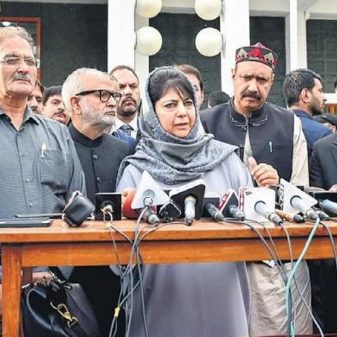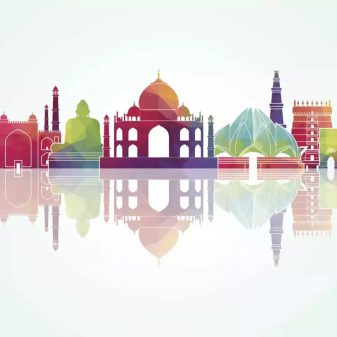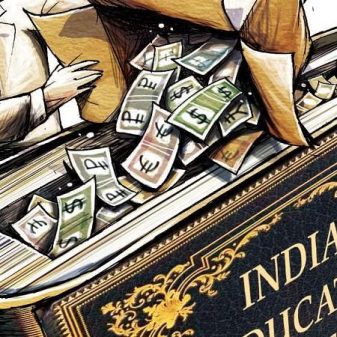
Nanditha Krishna
The Uttiramerur inscription is excellent inscriptional evidence of local democracy and administration during the time of the Cholas.
We are told that there were no historians in ancient India: the Vedas are all about Gods, the Ramayana and Mahabharata are myths, and Indian history began with the Buddha and Alexander. But this is not true. It is what the British wanted us to believe and their leftist historian chelas took further.
The first historical event recorded by Rishi Vashishtha Maitravaruni in the Rig Veda (VII.18) was the Battle of the Ten Tribes, between Sudasa and his warriors against cattle thieves consisting of the Anus, the Druhyus led by their king Gandhara, Pakhta or Pakhtoons, Bhalana of the Bolan region in Baluchistan, Alina of Nuristan (eastern Afghanistan), Parsu or Persians, Prithu or Parthians of northeast Iran, Panis of Pakistan-Afghanistan and the Matsyas of Rajasthan-Haryana, among others. Dasas, said the British, were Dravidians and enemies of Aryas. But Sudasa was an Arya fighting the tribes of the north and west. British history of India was wrong.
Indian history writing began with two itihasas. Rishi Narada narrated the Ramayana, about Rama, to Valmiki; the latter made it into a fantasy full of flying monkeys and demons. The Mahabharata, the story of two battling branches of Kurus, was originally called “Jaya” (“Victory”), with 8,800 verses attributed to Vyasa. Unfortunately, as it belonged to the oral bardic tradition, verses were added by itinerant singers. Today, there are over 1,00,000 shlokas.
With Alexander came Megasthenes who wrote Indica. He lived between 350 and 290 BCE and was an ancient Greek historian, diplomat, ethnographer and explorer. He left behind valuable observations of India. Stone carving came into vogue at this time. Kings left inscriptions, coins and palm leaf manuscripts that tell us about their favourite deities, dynasties and more.
Of the ancient historians and biographies, Harshacharita was a biography of the Indian ruler Harsha by Bana, a Sanskrit writer who wrote the first historical biography containing vivid descriptions of society and nature in Sanskrit in 640 CE. Parimala Kalidasa, a Paramara court poet who lived in the 10th–11th century, wrote about the Paramara king Sindhuraja who ruled Malwa. Bilhana of Kashmir left home and wandered through Mathura, Kanauj, Prayag, Varanasi, Somnath, Kalyan and Rameswaram. On his return journey, the Western Chalukya King Vikramaditya VI invited him to be the royal vidyapati. Bilhana (11th century) composed the epic Vikramankadevacharita.
In 1191–1192 CE, Jayanaka, a Kashmiri poet-historian in the court of Prithviraj Chauhan, wrote the Prithviraja Vijaya (“Prithviraja’s Victory”) about Prithviraj and his ancestors, on a birch bark manuscript in the Sharda script. The poem mentions Prithviraja’s victory over Muhammad Ghori in the first Battle of Tarain but not about his defeat in the second: it was obviously written between the two battles. Kalhana wrote the history of Kashmir, the Rajatarangini, in Sanskrit in the 12th century. Sanskrit was still the language of literature at this time.
Meanwhile, South India developed its own history. Ashoka, in the 3rd century, had mentioned the kingdoms of the Pandyas, Cholas, Cheras and Satiyaputras (Athiyamaan) beyond his empire. King Kharavela in his Hathigumpha inscription (150 BCE) refers to the Pandyan king and a league of Tamil kingdoms that had existed 113 years earlier. The earliest readable Tamil inscriptions, dating to 200 BCE, were found near Madurai. These are the oldest Jain inscriptions in South India. The Alagarmalai inscriptions of the 1st century BCE record the endowments made by a group of merchants from Madurai, while 3rd century CE inscriptions on rocks in Wayanad district in Kerala refer to the Chera dynasty.
Sangam literature, which starts from about 200 BCE, documents kings, dynasties and their achievements. Maduraikkanchi by Maruthanaar describes Madurai and the Pandyan kingdom. Netunalvatai by Nakkirar describes the palace of king Nedunchezhiyan III. The Purananuru and Akananuru describe several kings, and some literature was composed by the kings themselves. Pathirruppathu provides the genealogy of four generations of Cheras and descriptions of Chera country.
Works like Ainkurnuru, Akanaanuru, Kuruntogai, Natrinai and Purananuru tell us about ancient kings, while Pattinapaalai describes the port city of Kaveripoompattinam and the arrival of food from Eelam or Lanka. The first inscriptional reference to a Sangam chieftain, Atiyamaan Netumaaran Anci of Takatur, is found at Jambai, belonging to the 1st century CE. Inscriptions from the 2nd century CE at Pugalur near Karur and 4th century CE at Arachalur are important records too.
Inscriptions and coins have been found all over Tamil Nadu and South India mentioning the rulers, society, religion and administration. The Uttiramerur inscription is excellent inscriptional evidence of local democracy and administration during the time of the Cholas. The Pandyas, Cheras, Cholas and Pallavas left their histories in the form of elaborate inscriptions and literature on temple walls and copper plates.
Medieval Islamic historians were better-known because the British utilised their writings. Babur wrote his memoire, the Baburnama. Abul Fazl wrote the Akbarnama. Badayuni wrote his Tarikh which chronicles Mughal history from Babur to Muslim scholars, physicians and writers. Firishta wrote his Tarikh, containing the kings of Ghazni, Lahore, Delhi and Dakhin—divided into chapters on Gulbarga, Bijapur, Ahmadnagar, Berar, Bidar, Gujarat, Malwa, Khandesh, Bengal, Bihar, Multan, Sind and Kashmir.
There are similar sources of history from every state. Our historians quote British historians who wrote with a specific agenda of belittling Hindu civilisation and dividing Muslims and Hindus. We know the Muslim kings who defeated Hindus, but nothing about Hindu kings who defeated the Muslims, like Ranbal and Jayapala, Shahi kings of Afghanistan, Bappa Rawal, Rana Pratap, Raja Prithu the Ahom, Rana Sangha and the Chandela king Vidyadhara who chased Mahmud Ghazni back to Afghanistan. A more balanced view of Indian history will appear when we rewrite history from local sources.
(The writer is a Historian, environmentalist and writer based in Chennai)(Courtesy:The New Indian Express)





